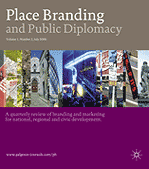How can cities and towns develop a brand position that is credible, drives growth, involves residents and fosters sustainability? Viriya Taecharungroj, together with Morakot Muthuta and Pheereeya Boonchaiyapruek of different universities in Thailand wanted to find out.
We caught up with Viriya to learn about the results of their “sustainable place branding analysis”, which was published in the Journal of Place Branding and Public Diplomacy.
Learn about the main research insights and implications for town and city brand managers in Thailand, Asia and beyond.
Viriya, you recently published an article on sustainability as a place brand position – using ten towns near Bangkok as an example. What brought you to investigate this topic?
As a developing country, Thailand has progressed in ways that undermine the global effort for more sustainable development. Thailand Science Research and Innovation (TSRI), a national research agency, wanted to find new ways to help towns and cities to develop sustainably. I was in touch with TSRI and proposed the research idea that could help local governments.
Our team worked with the ten towns in the vicinity of Bangkok because being so close to the capital makes them the most vulnerable to unsustainable urban sprawl. We wanted to find ways to show them how they can be part of this positive movement towards more sustainable cities.
Which are the main insights from your research?
Sustainability is a multi-faceted concept which requires a multi-faceted analysis. We found that there is no best way to use sustainability to brand a city or town.
To better understand our town, we proposed a simple analysis called “Sustainable Place Branding Analysis” (SPBA) which is an adaptation of the popular Importance-Performance Analysis (IPA).
Through the analysis of the ten towns, we identified five types of “sustainable” towns, including elegant, compassionate, lively, peaceful, and green towns. These five types are preliminary ones; it would be interesting to do more research on this and to observe the differences.
Your advice to city or destination organizations, how to deal with the topic of sustainability with regards to place branding – do’s and don’ts?
Our main advice is not to think of sustainability as a goal, but as a “process”. We cannot put up a sign and call our city or town “sustainable”. Sustainability is a process in which we continually measure, learn, and improve.
Furthermore, it is unlikely for any town to be exemplary in every aspect of sustainability. This research helps towns realise that it is ok to be behind in some issues (so, improve them!). The focus is on the aspects of sustainability that a town performs well in and which residents regard as important.
Our tool helps towns to identify those “brandable” aspects of sustainability and encourages them to incorporate them into their branding strategy.
What impact does a place’s sustainability performance nowadays have on its ability to attract visitors, new residents, business or talent?
As far as I know, there is no such study that quantifies such impact of sustainability on the city’s ability to attract those target groups.
Still, there are obvious trends that point towards the impact and importance of sustainability. For example, sustainable tourism is on the rise; sophisticated travellers are much more concerned about their carbon footprint and other negative impacts, e.g. on the local communities.
The new generations of workers and consumers are more aware of sustainable practices. These conscious consumers do not only come from developed nations: a massive segment population in developing countries, such as China and India, are sustainability conscious.
Moreover, businesses and organisations worldwide are being pressured to adopt sustainable practices. So, despite a lack of studies (to my knowledge) on the topic, the trend is that stakeholders are looking for sustainable cities and towns.
How can sustainability be used as place brand tool – rather than “just” luring potential, environmentally conscious visitors to the place?
Brand communications are important activities for places. So, luring potential visitors, new residents, and business is not necessarily a bad thing.
What we have to keep in mind is the actions before and after the “lure”. The communication strategy needs to start with a thorough understanding of our place image and identity, and how they are related to the sustainability narrative.
Then, sustainability has to be part of the brand position that is both credible and growth-driven. The brand architecture needs to be synchronised across multiple levels of places (e.g. it could be hard to be a very green town in a heavily industrialised region).
Then, the brand experiences that visitors and residents encounter need to be aligned with the communicated brand. We need the whole package of brand management to ensure the credibility of our “lure”.
Which are the main dangers and pitfalls for city and destination managers and marketers, linked to using sustainability as part of their brand promise and advertising?
When we interviewed the local governments in Thailand, we found two common pitfalls. First, some officials do not know what sustainability is. Sustainability is multi-faceted; it comprises many factors. There is no one single thing/policy/intervention that improves sustainability. We cannot improve sustainability without paying attention to the underlying factors.
Second, for those that understand the multi-faceted nature of sustainability, it is unlikely for us to be great at everything! Understandably, some towns want to say that their economic growth is good, social justice is perfect, the natural environment is a top-drawer, transport and energy are first class, etc.
However, it is more important to know which factors we perform very well in, and which we do not. Then we can use different strategies to brand, educate, or improve those factors of sustainability.
Which trends do you observe in Asia, how countries, regions or cities use sustainability in their brand positioning?
Asia is undergoing rapid changes, which lead to unintended negative outcomes such as poverty, deforestation, pollution, and overconsumption.
Some cities and countries are investing heavily to promote sustainability. Singapore’s “Gardens by the Bay” is an outstanding place innovation that fused technology with nature. Singapore has also been recognised as a leader in technology and business. We are currently seeing how it can use its obvious competence to push for sustainability.
China has obviously been doubling down on investments in renewable energy to establish its sustainable image. Nevertheless, their overseas infrastructure investments in other developing nations through the Belt and Road initiative are not primarily sustainable! It is interesting to see how China will manage to combine its intention to be sustainable and its aggressively expansive investment strategy abroad.
Which topics linked to place branding, marketing and sustainability would you consider important to address in future research?
The main question is, “Is it worth it?”
Certainly, we want places to continuously brand and develop themselves sustainably. However, economic difficulty and short-term political gains can distract towns and cities, especially the ones in the developing countries, to brand and promote themselves otherwise. They may want a large industrial investment from a large business that can generate quick cash but will also emit pollution. They may want a large retail chain that can create jobs and footfalls but will also destroy local independent businesses.
Our task is to show cities and towns that sustainability is good for the town, your people, and the environment.
Thank you, Viriya.
More about the study here.
 The Journal
The Journal
Place Branding and Public Diplomacy is the first and only journal to concentrate on the practice of applying brand strategy and other marketing techniques and disciplines to the economic, social, political and cultural development of cities, regions and countries. Edited by Robert Govers and James Pamment.
Enjoyed this research update on sustainability as place brand position in urban Thailand, the importance of sustainability in place branding and the challenges? Thanks for sharing!


